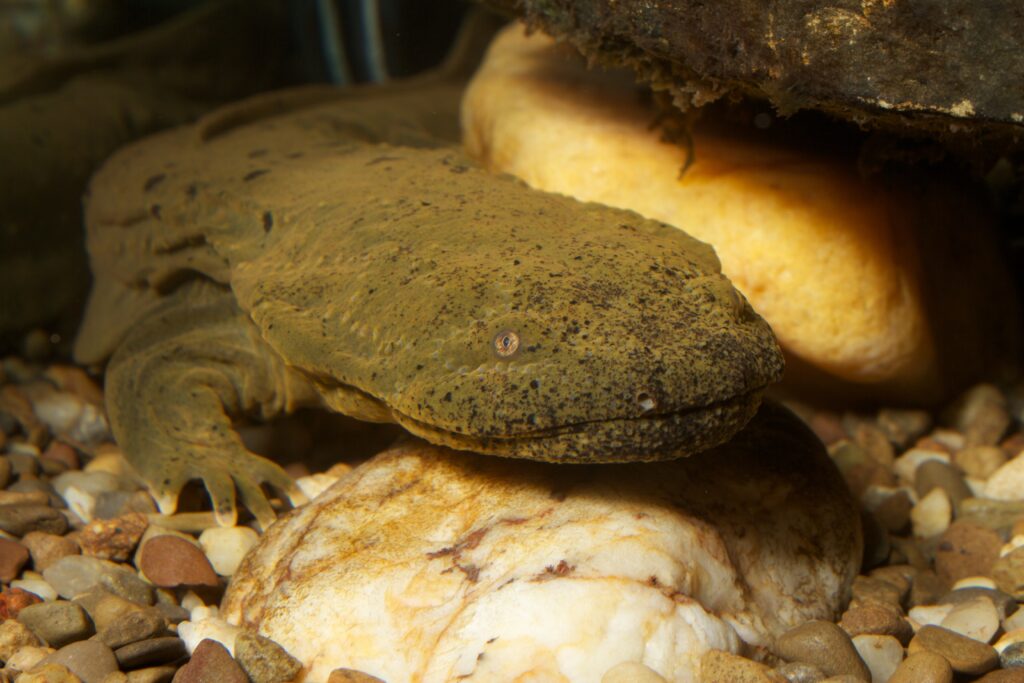This salamander and the federal Act that protects it shows how government can protect the things we all love.
By Dalton George

Kids ran around their parents’ legs, waving a sticker adorned with two Eastern Hellbenders, adding to a crowd of nearly 100 people on a sunny day last summer. One especially astute kid pointed at the clearly visible mural with the same image, asking why we were hosting an unveiling for something he could already see had been painted on a large wall on Howard Street in downtown Boone.
Smart kid.

That mural was a joint project funded and organized by Boone alongside several environmental and biodiversity organizations committed to the preservation of wildlife like the Hellbender. In a political climate hellbent, no pun intended, on the polarization of every issue, it’s rare to see so many rally around something like this critter. The mural now proudly reflects Downtown Boone, encouraging residents and visitors to recognize the need for the protection of our natural spaces.
The Hellbender has become an almost mythical Appalachia and Western North Carolina creature. Breweries everywhere use their image on their cans and branding; restaurants name themselves after the salamander, local sports leagues adopt it as a mascot, and Appalachian Trail through-hikers adopt one of its colloquialisms as their trail name – Snot Otter, Mud Puppy, Alleghany Alligator, Devil Dog, Lasagna Lizard, Walking Catfish. With names like that, the Hellbender is hard not to love. It’s North America’s largest salamander and one of the largest amphibians in the world.
The Hellbender is far more than just a mascot. These salamanders keep aquatic invertebrate populations in check as predators in our rivers, as all native creatures play a key and irreplaceable role in their home ecosystems. Hellbenders are also one of the best indicators of water quality; simply put, where there are Hellbenders, there are clean streams.
Strong federal protections for the Eastern Hellbender wouldn’t just guarantee their existence for future generations. It would be an ambitious step to protecting clean water for communities across Appalachia.
The Hellbender is currently under review to be listed as endangered under the Endangered Species Act, as populations have dwindled due to pollution and overdevelopment. In many ways, its resiliency is part of what makes it so distinctly Appalachian. While development and the gentrification of Appalachia continue to displace historic working families, they’re also pushing out the Hellbender.
Hurricane Helene certainly didn’t help the Salamander of Appalachia, with its damage to water quality, increase in erosion, and the destruction of streambanks and vital habitats. But like the people of these mountains, the Hellbender has been seen striving to find a return to stability against the odds, and often without recognition.
I wrote and introduced a resolution supporting the listing of the Hellbender as officially a part of the endangered list.
Shortly after Boone passed its resolution last month, I heard how officials in Buncombe County had seen what we were doing and wanted to weigh in. Buncombe, which contains the city of Asheville, was hit hard and is displaying its own doggedness as the county rebuilds after devastating damage from Hurricane Helene.
Buncombe delivered, passing a similar resolution about the Hellbender in early February, showing regional buy-in and unity.
These two resolutions translate to nearly 250,000 Western North Carolinians who are represented by local governments in support of this listing. Polls show that 84 percent of Americans support the Endangered Species Act, but in the halls of Congress, it remains one of the most attacked pieces of legislation. The reality is that these anti-wildlife politicians are out of touch with what the public in their district wants, mainly as a result of corporate influence and special interests, namely corporate agriculture companies and big developers. So, it’s on local governments to make a stand, to amplify the voices of their many constituents who believe in an empowered ESA and an active government in conservation.
Maybe the story of the Hellbender shows a path forward on issues we can all rally behind. In spite of the attacks on the ESA and the vital safeguards of our natural spaces in the halls of Congress and in the General Assembly in Raleigh, local communities uniformly and widely want their environment protected.
Most North Carolinians want to look out for their neighbors. And given the Hellbender’s charm, ability to care for our creeks and rivers, and status as a native of these Appalachian mountains, I’ve found most people I know going to bat for this neighbor too — even if it happens to be North America’s biggest salamander.